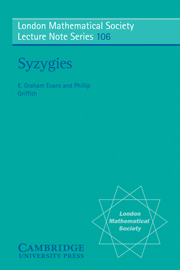Book contents
- Frontmatter
- PREFACE
- Contents
- CHAPTER 0 FOUNDATIONS
- CHAPTER 1 COUNTING DEPTHS
- CHAPTER 2 BASIC ELEMENT THEORY
- CHAPTER 3 FUNDAMENTAL THEOREMS ON SYZYGIES
- CHAPTER 4 SELECTED APPLICATIONS
- CHAPTER 5 FILTRATIONS OF MODULES BASED ON COHOMOLOGY
- CHAPTER 6 VECTOR BUNDLES ON THE PUNCTURED SPECTRUM OF A REGULAR LOCAL RING
- APPENDIX: SOME CONSTRUCTIONS OF VECTOR BUNDLES
- REFERENCES
- INDEX
CHAPTER 5 - FILTRATIONS OF MODULES BASED ON COHOMOLOGY
Published online by Cambridge University Press: 05 May 2013
- Frontmatter
- PREFACE
- Contents
- CHAPTER 0 FOUNDATIONS
- CHAPTER 1 COUNTING DEPTHS
- CHAPTER 2 BASIC ELEMENT THEORY
- CHAPTER 3 FUNDAMENTAL THEOREMS ON SYZYGIES
- CHAPTER 4 SELECTED APPLICATIONS
- CHAPTER 5 FILTRATIONS OF MODULES BASED ON COHOMOLOGY
- CHAPTER 6 VECTOR BUNDLES ON THE PUNCTURED SPECTRUM OF A REGULAR LOCAL RING
- APPENDIX: SOME CONSTRUCTIONS OF VECTOR BUNDLES
- REFERENCES
- INDEX
Summary
In this chapter we will explore two filtrations which have their origins in the comprehensive work of Auslander and Bridger (1969). The first of these filtrations was also considered by Horrocks (1980), in its dual form, in obtaining filtrations for vector bundles on projective space. In its original form this filtration was called a “spherical” filtration by Auslander and Bridger, since each module in the filtration has exactly one nonzero cohomology. The second filtration actually turns out to be a filtration of a (possibly nonminimal) free presentation of a module (see Evans and Griffith (1985b) and Theorem 5.5). It can be used to isolate a particular Ext-cohomology for closer scrutiny. One important feature of this filtration is its strong uniqueness properties which we exploit in Chapter 6 in the context of extending vector bundles. In part, the reason for studying the filtrations in this chapter is to gain information and, as well, focus attention on two problems of interest.
The first of these problems is concerned with kth syzygies of rank k over regular local rings. At this point we mention that the regular local ring R in question must contain a field so that the main results of Chapter 3 apply. From Bruns' Theorem (Theorem 3.11) we know that a kth syzygy M of rank larger than k contains a free submodule F so that M/F is a kth syzygy of rank exactly k.
- Type
- Chapter
- Information
- Syzygies , pp. 76 - 91Publisher: Cambridge University PressPrint publication year: 1985



